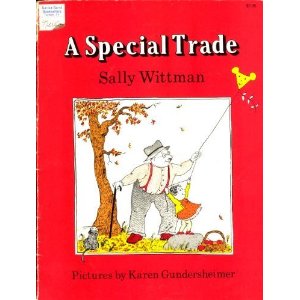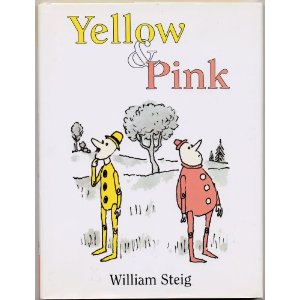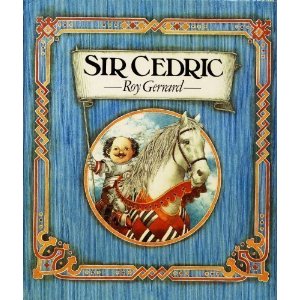
I’ve wanted an excuse to share with moms, dads, grandmas, grandpas, and anyone else who reads to little ones three of my favorite picture books for children, none of which are any longer published but are available in public libraries and can be purchased used online. A holiday weekend in the summer seems the perfect excuse.
The books are A Special Trade by Sally Wittman, Yellow and Pink by William Steig, and Sir Cedric by Roy Gerrard.
 A Special Trade is the story of a little girl Nelly who is taken for daily stroller rides to a neighbor’s vegetable garden by her elderly neighbor Old Bartholomew. They encounter friendly dogs and unfriendly dogs. Old Bartholomew warns Nelly of bumps in their path which elicit recurrent shouts of “BUMP!” from Nelly. And when a sprinkler intrusively sprays water in their path, Old Bartholomew yells “Charge” as they hurtle through the spray.
A Special Trade is the story of a little girl Nelly who is taken for daily stroller rides to a neighbor’s vegetable garden by her elderly neighbor Old Bartholomew. They encounter friendly dogs and unfriendly dogs. Old Bartholomew warns Nelly of bumps in their path which elicit recurrent shouts of “BUMP!” from Nelly. And when a sprinkler intrusively sprays water in their path, Old Bartholomew yells “Charge” as they hurtle through the spray.
One day, Old Bartholomew doesn’t come for Nelly. Day after day passes and then one day he returns in a wheel chair. The smile was “gone from his eyes,” and he could no longer push Nelly in her stroller. Undaunted, the Nelly takes hold of his wheel chair and takes Old Bartholomew for their daily walks, hurtling through the sprinkler as if nothing has changed.
It’s a heartwarming story that portrays through the simplest of acts the worth of all people, including those who possess little of those things that preoccupy Americans, like physical perfection, wealth, or power. While we worship at the altar of everything new and showy, this book shows the richness of routine and simplicity. While the culture tells us to put ourselves first, this book shows that joy comes from sacrificing for others and that interdependence is not only unavoidable but beautiful. And in a culture that recoils from aging and warehouses the aged, this book shows what both aging and the aged contribute.
 Yellow and Pink by William Steig is the story of two wooden puppets, Yellow and Pink, who debate their origins, with Yellow arguing that they came to be through random accidents of nature while Pink believes they were designed.
Yellow and Pink by William Steig is the story of two wooden puppets, Yellow and Pink, who debate their origins, with Yellow arguing that they came to be through random accidents of nature while Pink believes they were designed.
Pink found “Yellow’s color, his well-chiseled head, his whole form admirable. ‘Someone must have made us,’ he said.” Yellow responds, “’I say we’re an accident, somehow or other, we just happened.’”
As their debate progresses, the arguments of Yellow, who denies a maker, become increasingly absurd. Yellow says, “’Suppose a branch broke off a tree and fell on a sharp rock in just the right way, so that one end split open and made legs….There you have legs. Then winter came and this piece of wood froze and the ice split the mouth open. There’s your mouth. Then maybe one day a big hurricane took that piece of wood and sent it tumbling down a rocky hill with little bushes, and it got bumped and chipped and brushed and shaped this way and that. Sand blowing in the wind might have helped with the smoothing. That piece of wood could have hung around at the bottom of that hill for eons, until one day—ZING!—lightning struck in such a way as to make arms, fingers, toes.’”
Yellow’s conjecturing continues becoming ever wilder until the enormous puppet-maker appears, picks up his two creations, and walks away with the clueless puppet asking his companion, “Who is this guy?”
As with all analogies, the correspondences between puppets and humans and between the puppet-maker and God are limited. But while the image of humans as puppets is perhaps inapt and the image of God as a puppet-maker who needs a haircut and sings out of tune is definitely inapt, Steig’s depiction of Yellow’s intellectual contortions in the service of denying his obvious design and the possibility of a designer hilariously pokes at the “logic” of atheist elitists.
 Sir Cedric by Roy Gerrard is the story of a “cheerful and gallant” and “gentle but bold” knight who rescues and ultimately marries the pudgy Princess Matilda from imprisonment by the evil knight, Black Ned.
Sir Cedric by Roy Gerrard is the story of a “cheerful and gallant” and “gentle but bold” knight who rescues and ultimately marries the pudgy Princess Matilda from imprisonment by the evil knight, Black Ned.
After Matilda’s parents consent to Cedric and Matilda’s marriage, word comes that Black Ned is returning with an army to seek revenge and recapture Matilda. The King’s men begin to succumb to fear, but Sir Cedric, like Shakespeare’s Henry the V in his St. Crispin Day speech, inspires them to fight for justice against the bully Black Ned. The battle ensues and Black Ned is defeated, following which Sir Cedric shows him mercy, which transforms Black Ned.
Though the story follows a conventional heroic storyline, it is remarkable because it is written in rousing rhymed verse with a delightful vocabulary and glorious illustrations. What is even more remarkable is that Roy Gerard is both the writer and illustrator.
Cultural critics regularly criticize the dumbing down of America, as evidenced by the unsophisticated level of rhetoric found in political speech and our daily newspapers. Children’s vocabularies and their imaginations will be fed by spending time in the worlds created by Roy Gerrard.






























